Are you looking to spice up your succulent collection with spiky leaves?
Some have sharp harmless spikes at the end of the leaves, others have cute toothed and serrated leaves.
Take a look at the 26 most popular succulents with spiky leaves.
Agave
1. Saw Leaf Agave (Agave Xylonacantha)
With loose, star-shaped rosettes, the long yellow-green leaves of the Saw Leaf Agave have long, light-colored spikes that grow about 1 inch (2.5 cm) apart along the edges.
The Saw Leaf Agave is also called the Century Plant.
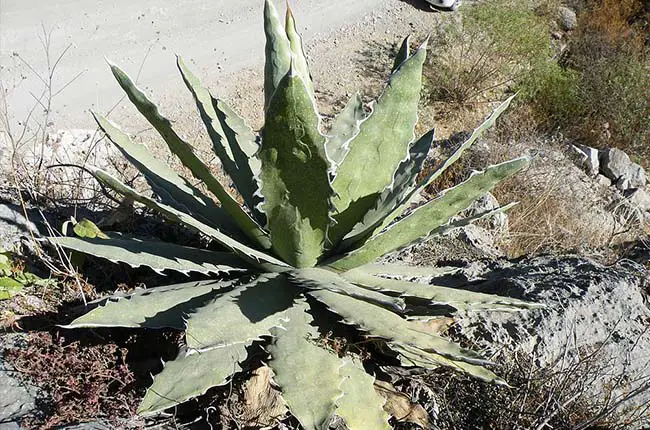
(Amante Darmanin from Malta, CC BY 2.0, via Wikimedia Commons)
2. Parry’s Agave (Agave Parryi)
The broad, flat leaves of Parry’s Agave are an attractive powdery blue-gray color, with dark ridges of short spikes along the edges of each leaf.
The plant flowers after 10 – 15 years on tall stalks that measure 6 – 20 ft (1.8 – 6 meters) in height. The red buds reveal yellow or golden-colored flowers.
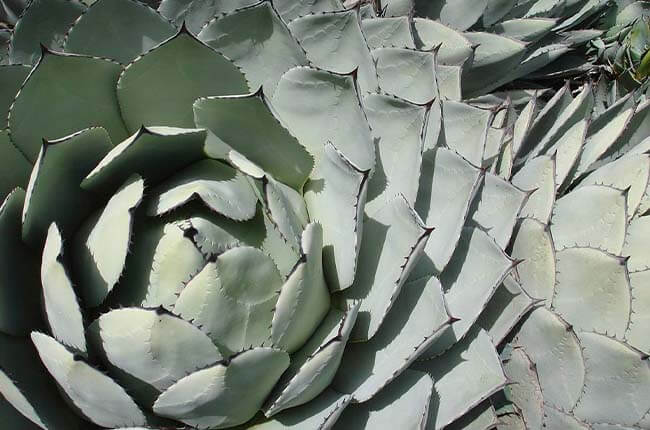
(Akos Kokai, CC BY 2.0, via Wikimedia Commons)
Aloe
3. Snake Aloe (Aloe Broomii)
This large, short-stemmed succulent can grow 4 – 5 ft (1.2 – 1.5 meters) tall with its inflorescence of pale yellow blossoms.
Its bright green rosettes grow close to the ground while the thick, scaled stems grow from the center of the rosettes.
The edges of each leaf contain short brown spikes that grow close together.
Because of its size, Snake Aloe grows best outside but can be a popular and attractive houseplant if the container is large enough.
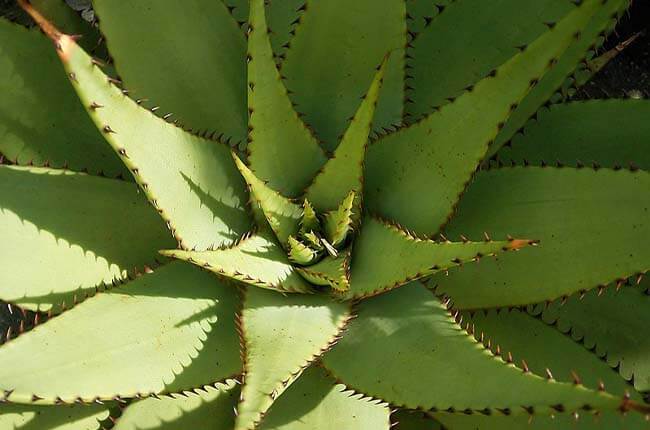
(Frank Vincentz, CC BY-SA 3.0, via Wikimedia Commons)
4. Tiger Tooth Aloe (Aloe juvenna)
This ferociously named aloe grows in vertical columns, often resembling a Christmas tree when viewed from the side.
The mottled green leaves are toothed, and the edges of each leaf turn reddish brown when exposed to a lot of sunlight.
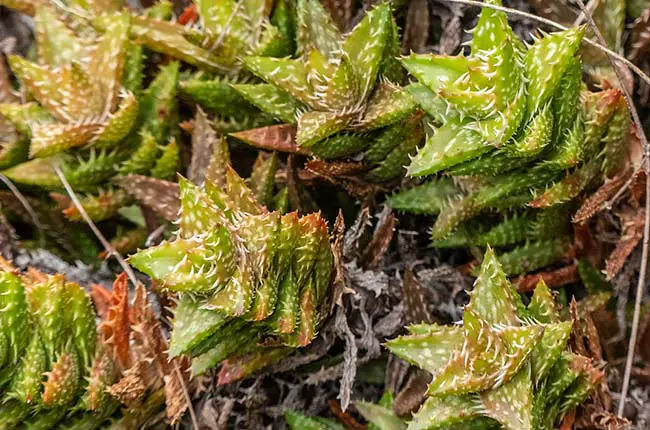
(John Robert McPherson, CC BY-SA 4.0, via Wikimedia Commons)
Dyckia
While not true succulents, as Dyckia don’t store water in the same way as genuine succulents, they are xerographic – meaning that they can go without water for extended periods of time by going dormant.
5. Dyckia goehringii
This silver bromeliad has star-shaped rosettes of long, spiky leaves. Rows of curved, white teeth edge each leaf.
It grows at higher elevations and is endemic to the middle mountains of Brazil.
Heavy rain or watering can wash off the silvery coating, revealing the dark green foliage beneath.
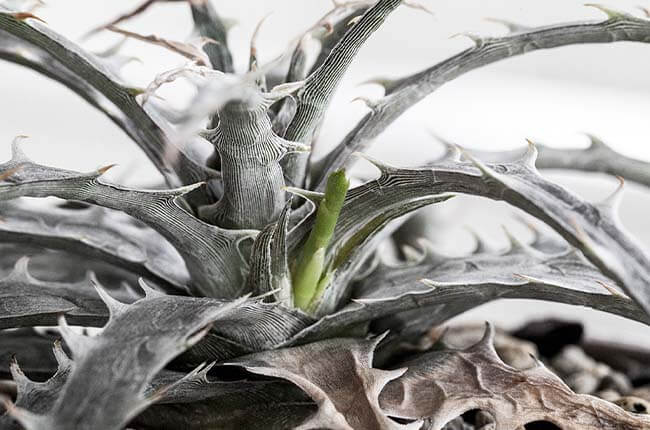
(Saito Makoto, CC BY 3.0, via Wikimedia Commons)
6. Dyckia marnier-lapostollei
This stemless, silvery succulent grows slowly and has powdery leaves that grow either straight outwards or curved and winding.
Curved, yellowish-white spikes grow uniformly along the edges of each leaf.

(Megan Hansen from Portland, OR, US, CC BY-SA 2.0, via Wikimedia Commons)
Cryptanthus
Also known as “bromeliads,” cryptanthus species are native to South America – primarily Brazil. They are also called “Earth Stars” due to the star shape of their rosettes.
7. Red Star Bromeliad (Cryptanthus bivittatus)
Also called the Ruby Star, this bromeliad has variegated leaves with brown and dark pink stripes.
The edge of each of the long, papery leaves is serrated with tiny brown spikes.
New plants spring from offsets that eventually replace the original “mother” plant after the plant successfully flowers.
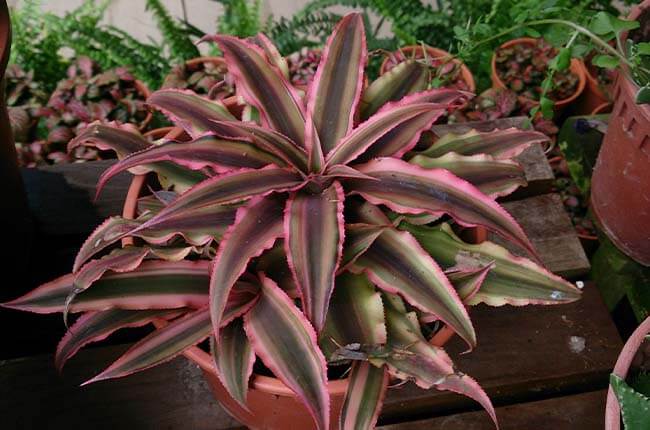
(Cryptanthus bivittatus) (Mokkie, CC BY-SA 4.0, via Wikimedia Commons)
8. Cryptanthus warren-loosei
This bromeliad has star-shaped rosettes and long, serrated brown leaves that can grow up to 12 inches (30 cm) long. Small spikes edge each leaf.
During the summer, small white flowers spring from the center of each rosette.
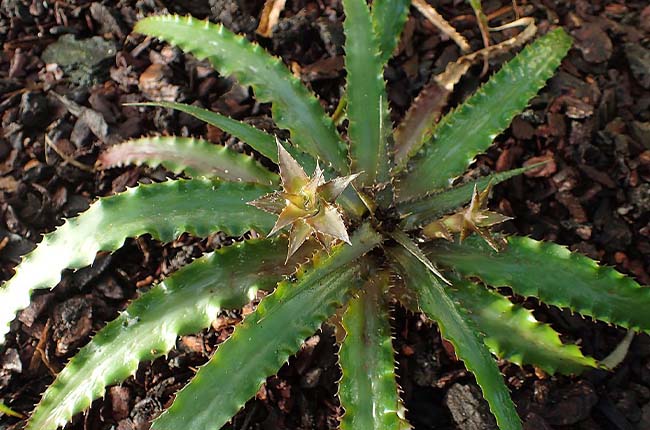
(Krzysztof Ziarnek, Kenraiz, CC BY-SA 4.0, via Wikimedia Commons)
Euphorbia
While many euphorbia species resemble cacti, they are in fact spurges – a kind of desert succulent shrub without large flowers and no sap. Many are mildly to moderately toxic to humans and animals.
9. Spurge (Euphorbia Stellata)
This unusual succulent has thick, fleshy trailing tubercles that produce double brownish spikes (or teeth) on the ridges alongside each winding tubercule.
The tubercles spring from the top of a single bulbous woody trunk.
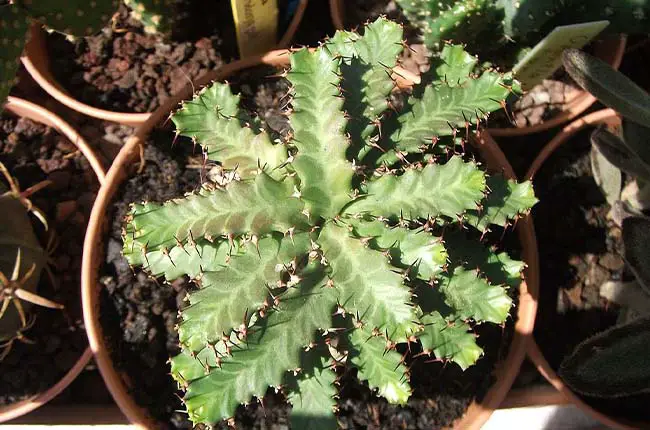
(D.Georgi, CC BY-SA 3.0 DE, via Wikimedia Commons)
10. African Milk Tree (Euphorbia trigona)
Popular as both a large indoor houseplant and an outdoor plant, the African Milk Tree is named for the mildly toxic white sap that seeps from the cactus when cut.
The African Milk Tree has stiff, dark green flesh and grows upwards in thick cylinders.
Thin oval leaves grow from the spiky vertical ridges on its sides. The spikes are usually brown and measure between a quarter and half an inch.

(carrotmadman6 from Mauritius, CC BY 2.0, via Wikimedia Commons)
11. Candelabra Cactus (Euphorbia lactea)
The common name of this succulent is a misnomer, as euphorbia lactea is a succulent but not a cactus. It is named for the way its three-sided arms branch out to the sides from a single stem.
A less flattering common name for this succulent is the Toxic Mottled Spurge, due to its mottled green and white coloration and toxic nature.
The spikes are dark brown and measure from 1/4 to 1/2 inch (6 – 13 mm) long.
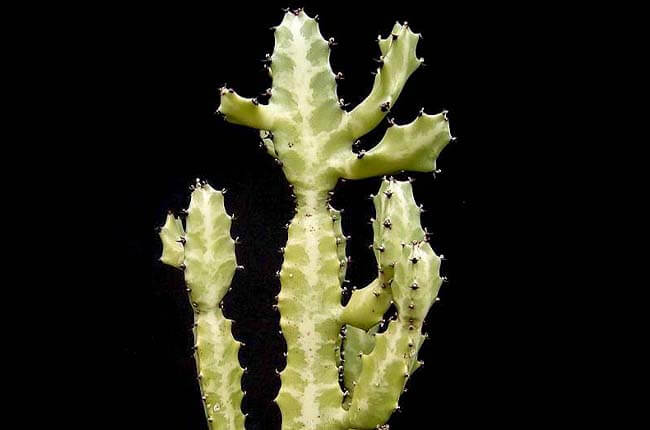
(Frank Vincentz, CC BY-SA 3.0, via Wikimedia Commons)
12. Desert Cactus (Euphorbia ammak)
The Euphorbia ammak grows in single pillars with spiky vertical ridges, each whitish-gray point measuring a 1/4 to 1/2 inch (6 – 13 mm) in length.
Between the ridges, the stiff flesh of this succulent is smooth and medium green, with no mottling or speckling.
Despite “cactus” being in this species’ common name, the “Dessert cactus” is not a cactus, but a spurge – a desert succulent similar to cacti.
It grows up to 30 ft tall or even more, native to Yemen and Saudi Arabia.
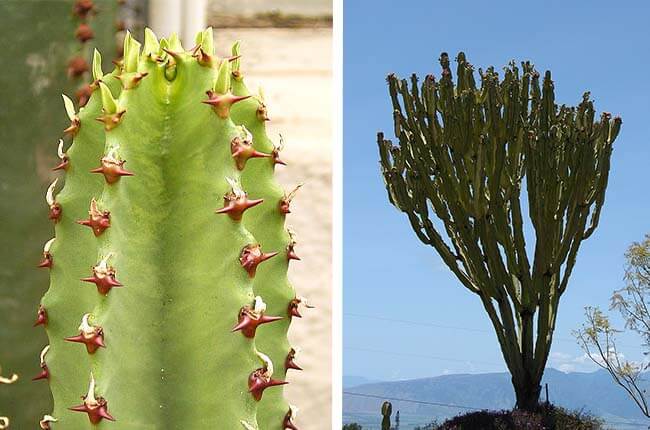
(Forest & Kim Starr, CC BY 3.0 US, via Wikimedia Commons) /
(Frank Vincentz, CC BY-SA 3.0, via Wikimedia Commons)
Faucaria
13. Tiger’s Jaw (Faucaria Tigrina)
Native to South Africa, this small succulent grows naturally in crevices between rocks.
Its thick, triangular leaves are toothed and serrated, the white tubercles spiky and edging each leaf.
Yellow flowers bloom during the winter and fall on short stems from the center of the rosettes.

14. Pebbled Tiger’s Jaw (Faucaria tuberculosa)
Also known as Shark’s Jaws or Knobby Tiger’s Jaws, this faucaria species is known for its serrated, toothed triangular leaves.
The thick leaves grow densely packed on star-shaped rosettes.
Aside from the spiky tubercles, small white speckles cover the deep green leaves, distinguishing this species from the regular Tiger’s Jaw (Faucaria Tigrina).
Large yellow flowers that resemble dandelions bloom close to the leaves during the fall and winter on short stems.
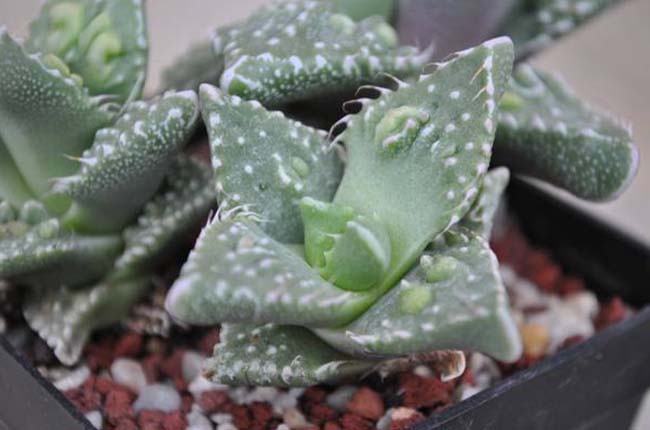
(AstroKaktus, CC BY-SA 3.0, via Wikimedia Commons)
Gasteria
These plants are commonly referred to as “Ox Tongues” in the botanical community, due to the broad, rough nature of the leaves. Most species have thick, bumpy leaves, though others are smoother and thinner in appearance.
15. Knoppies Gasteria (Gasteria batesiana)
This unique gasteria species has a rough, bumpy texture due to the raised tubules all over their fleshy, triangular leaves.
The rosettes is star-shaped, with each leaf ending in a sharp white point.
Gasteria batesiana is seemingly the epitome of the “Ox Tongue” moniker, as the thick, stiff green leaves bear a striking resemblance to large tongues.
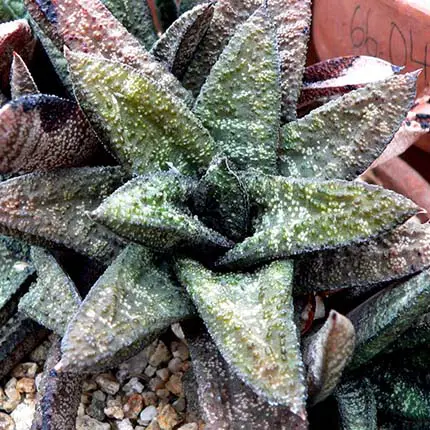
(Stan Shebs, CC BY-SA 3.0, via Wikimedia Commons)
16. Thicket Gasteria (Gasteria excelsa)
This spiky, star-shaped variegated succulent has long, dark green-blue leaves. The color is mottled, and the edges of the triangular leaves are sharp. Each stiff leaf ends in a sharp point.
During the summer, Thicket Gasteria produces tall, thin, upwards-growing stalks from which clusters of coral pink trumpet-shaped flowers grow.
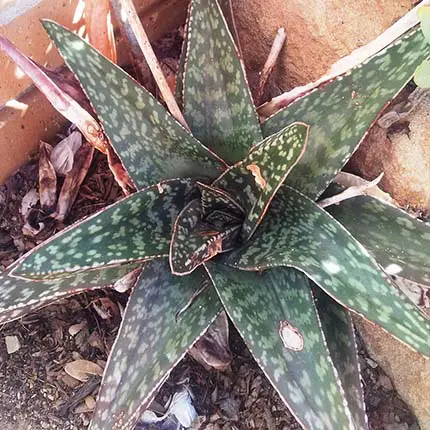
(S Molteno, CC BY-SA 4.0, via Wikimedia Commons)
Haworthia
17. Glassrim Haworthia (Haworthia mucronata)
The toothed, serrated leaves of this pale green succulent grow in densely packed rosettes.
Each leaf is fleshy, stiff, and grows upright, curving inwards.
If the succulent receives too much sun, the leaves turn yellow, red, or even white.
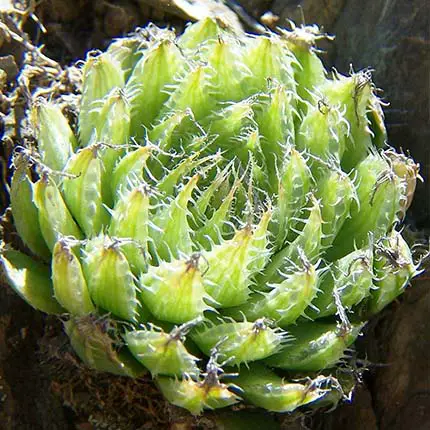
(Abu Shawka, CC BY-SA 4.0, via Wikimedia Commons)
18. Zebra Plant (Haworthiopsis fasciata)
This popular succulent is named for the ridged white nodes along fat, dark green leaves, each of which ends in a sharp point.
The spikes are stiff with bumpy, raised white horizontal stripes.
They are densely packed and grow up to 5 inches (13 cm) tall.
Small pink flowers bloom on tall, thin stems during the fall on Zebra Plants that are growing outside.
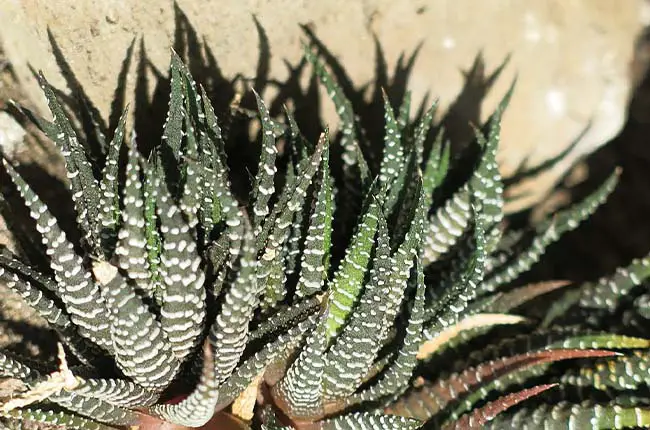
(Tangopaso, Public domain, via Wikimedia Commons)
Sansevieria
19. African Spear Plant (Sansevieria cylindrica)
True to its name, this plant has several tall spikes that grow upright with a slight curve.
Each spike has the shape of a spear, complete with a sharp tip. The spikes can grow between 4 – 6 feet (1.2 – 1.8 meters) tall if grown outdoors.
The African Spear Plant flowers sporadically, with tiny white flowers that grow in clusters.
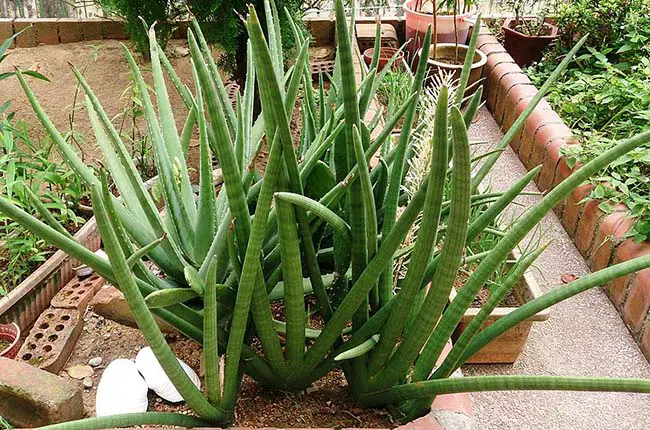
(Mokkie, CC BY-SA 3.0, via Wikimedia Commons)
20. Black Coral Snake Plant (Sansevieria trifasciata)
This succulent has stiff, dark green leaves marked with white to pale green cross banding, giving the leaves the unique appearance of snake skin.
Each of the pointed leaves grows straight up, reaching 35 inches (89cm) in height. The tip of each leaf sports a sharp, pointed tip.
During the summer, the Black Coral Snake Plant produces small clusters of white flowers.
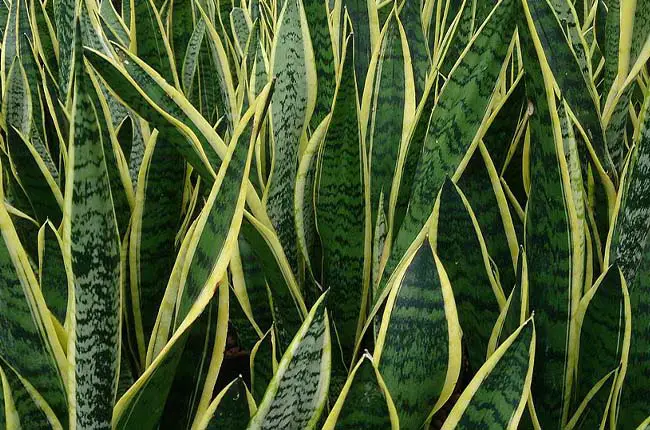
(Mokkie, CC BY-SA 3.0, via Wikimedia Commons)
21. Mother-in-Law’s Tongue (S. trifasciata laurentii)
This bold, popular plant has stiff, variegated leaves with bright yellow edges, the leaves wavering before ending with a stiff, sharp point.
It is a large plant, the leaves reaching up to 3 feet (90 cm) tall.
Tulista
22. Pearl Plant (Tulista Pumila)
Named for its raised, rounded tubercules that resemble pearls, the Pearl Plant has pointed, fleshy leaves that grow upright. Each of the fleshy leaves ends at a sharp point.
The rosettes are small to medium in size, growing 10 inches (25 cm) in width and about 8 inches (20 cm) in height.
While uncommon, the Pearl Plant sometimes sprouts offsets from which new plants grow.
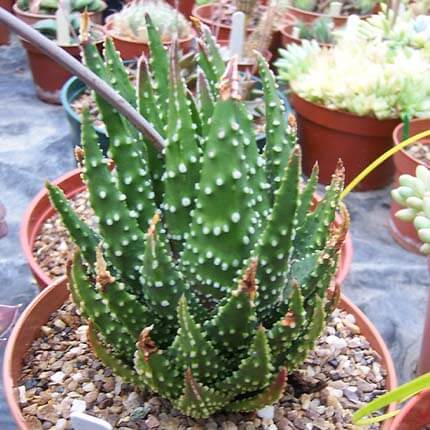
(stephen boisvert from Chicago, United States, CC BY 2.0, via Wikimedia Commons)
23. Tulista Minor
Known for its toothed, serrated leaves, tulista minor is a small succulent popular as a houseplant and in rock gardens.
The stiff, fleshy leaves are a dark green color with lighter-colored tubercules, giving the plant a fuzzy, speckled appearance. The leaves curve upwards and inwards as they grow.
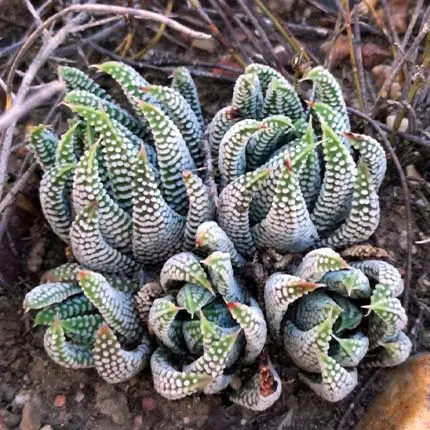
(S Molteno, CC BY-SA 4.0, via Wikimedia Commons)
Yucca
24. Joshua Tree (Yucca brevifolia)
This majestic yucca species is one of the most recognizable desert plants. Like many larger succulents, it grows slowly, reaching a height of 30 feet (9 meters) or more.
The thick, woody trunk is covered with thin, dried leaves that resemble hair from a distance.
Large rosettes (growing between 3 – 9 feet (90 – 270 cm) in width) grow at the end of each branch, sometimes in clusters of two, and sport long, thin, spiky yellow-green leaves.

(Robb Hannawacker, while working for Joshua Tree National Park, Public domain, via Wikimedia Commons)
25. Adam’s Needle (Yucca filamentosa)
This large desert succulent is prized for its large inflorescence of white, bell-shaped flowers that appear during the spring and summer.
The leaves are stiff, greenish blue, and pointed, donning multiple strands of curly white cilia that give it a fuzzy appearance.
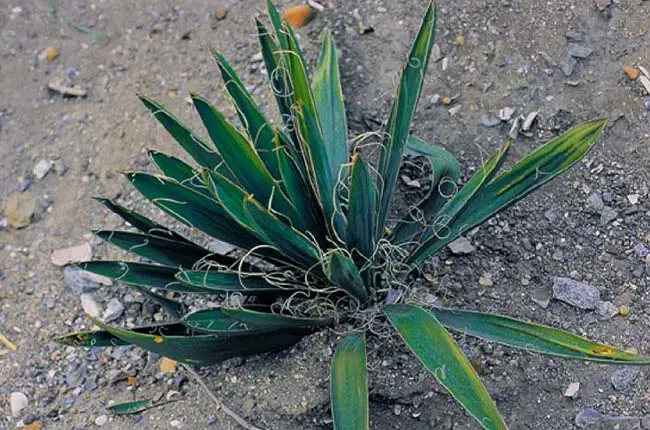
(Rebou, CC BY-SA 3.0, via Wikimedia Commons)
26. Red Yucca (Hesperaloe parviflora)
This eye-catching succulent is also known as the Hummingbird Yucca and the Coral Yucca, due to the soft pink-orange color of its trumpet-shaped flowers.
The leaves are thin and flexible, softer than those of other yucca species such as the Joshua Tree. The leaves are a unique blue-gray color and turn light brown and papery at the ends.
Curled white cilia spring from the edges of the pointed leaves, giving the yucca a fuzzy or hairy appearance.
Related
36 Rosette-Shaped Succulents (With Pictures)
14 Fragrant Succulents & Cacti (You Will Love)
Top 10 Spiral Cactus Types (with Photos)
25 Succulents with Long Stems (With Pictures)
- Keiki Paste vs Rooting Hormone:What’s the difference? - February 4, 2024
- Top 10 Orchid Fertilizers: A Comprehensive Review (2024) - February 2, 2024
- Top 8 Soil Inoculants For Stronger Plants (2024) - February 1, 2024
